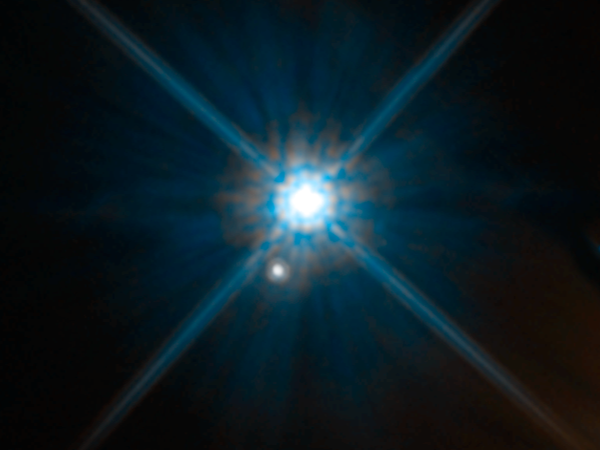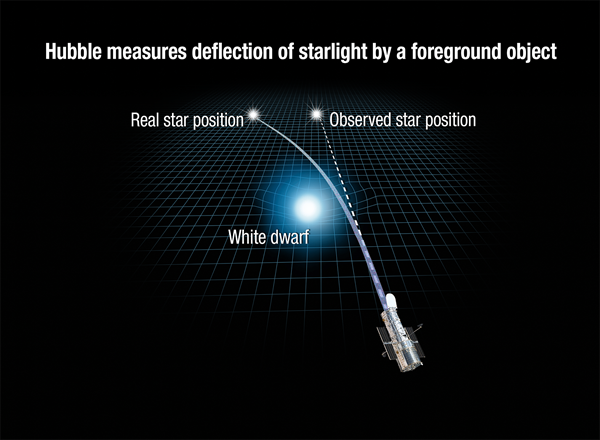Einstein’s theory of general relatively changed the way scientists look at the universe. The presence of mass bends spacetime like a bowling ball depressing a mattress, causing light to curve as it travels through these depressions on its way to Earth. In 1919, Sir Arthur Eddington confirmed this effect by measuring the deflection of background stars caused by our Sun during a total solar eclipse. Nearly a century later, astronomers have used the Hubble Space Telescope (HST) to measure this effect caused by a star outside our solar system for the first time.
This groundbreaking result was announced today at the 230th Meeting of the American Astronomical Society by Kailash Sahu of the Space Telescope Science Institute. Sahu’s team used HST to capture the deflection of light from a background star as a white dwarf, the remnant core of a star once like our Sun, passed in front of it as seen from Earth. Although this deflection was tiny – about 1,000 times smaller than the deflection measured by Eddington in 1919 – the precision achievable with Hubble allowed astronomers to see it clearly. From the deflection, they were able to measure the mass of the white dwarf, called Stein 2051B, in a new way that independently confirms the theoretical mass-radius relationship for white dwarfs. This is good news, because the mass-radius relationship is the foundation for astronomers’ use of these objects as standard distance indicators in cosmology. The work will appear this month in the journal Science.
To find a suitable pair of stars to accomplish this task, Sahu’s team first combed through a catalog of 10,000 stars with large proper motions, or movements on the sky as seen from Earth. Based on the motions of these stars, the team projected the stars’ positions forward in time to find a pair that would pass close enough to each other (when projected on the sky, not in physical space) to produce a bend in starlight measurable with HST.
Their choice: Stein 2051B, a white dwarf 17 light-years from Earth. According to the team’s calculations, Stein 2051B would pass in front of a distant background star, about 5,000 light-years away, causing the background starlight to bend by 2 milliarcseconds. In more understandable terms, seeing that bend would be like trying to watch an insect crawl across the face of a quarter from a distance of about 1,500 miles (2,400km).
The team enlisted Hubble to observe the stars over eight epochs, or points in time, with observations taken in the time leading up to, during, and after the event, which occurred in March 2014. And, indeed, they did observe a deflection of the background light as the white dwarf passed in front of the distant source.
This work represents two firsts in astronomy. One, it’s the first time a deflection due to general relativity has been measured using a star other than our Sun. And two, as Sahu explained during the press conference, measuring the mass of Stein 2051B is the first “clean test for [the] mass-radius relationship.”
The mass-radius relationship for white dwarfs leads to a limit called the Chandrasekhar limit. If a white dwarf accumulates mass past this limit (by stealing it off a binary companion), it will explode as a supernova, which can be seen from vast distances and can be used by astronomers to measure very large distances accurately. But if this relationship is different than we currently understand it, it would affect distance measurements based on white dwarf supernovae.
Three other white dwarf masses have been measured by astronomers. If this doesn’t seem like many, that’s because it’s not. Furthermore, the masses of those white dwarfs, including Sirius B, the tiny companion to the brightest star in the Northern Hemisphere, were all measured using the fact that they’re in binary systems. When two stars circle each other, astronomers can use information about the motions of the stars and the inferred mass of the non-white dwarf companion to calculate the mass of the white dwarf. This method, though, could be affected by a process called mass transfer between the stars, which would contaminate the mass-radius relationship measured.
While Stein 2051B does have a binary companion, it’s so far away from the white dwarf – at least 55 astronomical units, or 5 billion miles (8 billion km) away – that the two cannot be exchanging mass.
The final result? Displaying a graphic showing the mass-radius relation as a black line, Sahu explained, “Once we put [it] on this mass-radius relation … it should fall on this black curve here, and it falls right on that. So when I saw that it was right exactly on here, I almost fell off my chair.”
Stein 2051B is about 68 percent the mass of our Sun and about 2.7 billion years old. It is comprised of helium and carbon, which is exactly what astronomers expect for the remnant core of a Sun-like star. Stein 2051B’s perfect fit to the predictions made by the mass-radius relationship confirms our current evolutionary theory of white dwarfs and agrees with our understanding of the physics of the matter that makes up these objects. “This is really a confirmation of the theory that we have been using so far,” Sahu said.
And the success of Stein 2051B is only the beginning. Next up for Sahu’s group is trying to make this measurement using Proxima Centauri, but Sahu stressed that this method could be used to measure masses of neutron stars, black holes, and isolated massive stars as well.
“For a star, the single most important thing for the star is its mass. If we know the mass, we know what its radius will be, how bright it would be, how long it will live, what will happen after it dies. Everything depends on the mass of the star,” he said. “But we do not have a very good handle on measuring the mass in a model-independent way … So this at least gives another method to determine the stellar mass in a completely model-independent way.”
Now that this method can be applied to other objects to more easily weigh them, astronomers have a new, powerful tool at their fingertips able to provide details that before now have been calculated using models that rely on proxy measurements such as the type of light coming from the star or its motion in a binary system. This new, “clean” way of obtaining stellar masses will boost the measurements astronomers are capable of making in many fields, especially as the era of the James Webb Space Telescope dawns next year.











